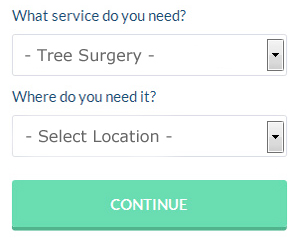Farington Tree Surgeons (PR25): Providing a much needed home for our ever decreasing wildlife, producing essential oxygen for our living environment and offering havens of shade on hot sunny days, trees are wonderful things to have and enjoy in our gardens. However, trees are living things and could get way too large for our gardens in Farington, suffer damage in windy conditions or become unhealthy and diseased. If issues crop up with your trees in Farington, a tree surgeon is the best person to contact.
Who you gonna call? A tree surgeon! - Tree surgeons in Farington play an essential role in the maintenance and general care of trees for a whole host of both public and private clients. There are innumerable examples of services a qualified tree surgeon in Farington may be able to provide: hazard assessments and inspections, the pruning of dead, weakened or intrusive branches, tree felling and removal, the safe planting of trees, along with general tree care.
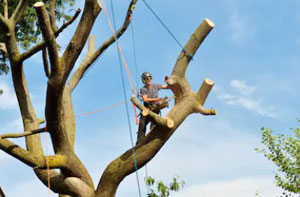
However, it isn't merely trees that get a tree surgeon's pulse racing! Such things as hedge maintenance and trimming, stump removal and shrub care, are amongst the additional responsibilities of a tree surgeon in Farington. The best tradesperson to hire if you have any worries about a tree's structural integrity is a tree surgeon, as they'll be able to examine your tree, put together a report on likely hazards, and give suggestions about ways to proceed.
Tree surgery is a hugely hazardous business and definitely a process that must only be tackled by an expert. It wouldn't be a smart decision to forgo and opt for the do-it-yourself approach, although this might seem to be an attractive alternative. To undertake the work that they do, tree surgeons have to be experienced, physically fit and qualified.
Tree surgery and care often involves the use of dangerous power tools whilst high up in the air and hanging from a harness in a tree. So, you can see why this isn't a task for amateurs! To complete a tree surgery project, a team of tree surgeons all experts at what they do, will usually be involved, and this should consist of both a ground team and climbers. An unqualified individual would find it nigh on impossible to carry out the work with this level of experience, competence and risk assessment.
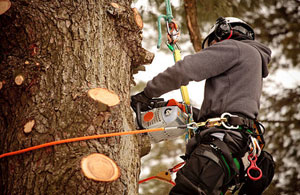
On resolving that you need the expert help of a tree surgeon in Farington, the first step is to find a good one that can be trusted. But, what is the best way to do this? Well, checking out things like experience, qualifications and cost will set you on the right track. Below we have summarized some valuable tips for finding the best Farington tree surgeon to take care of your trees.
The initial step will be to determine whether they have the required qualifications, this will give you confidence that they are competent and properly accredited. The National Proficiency Tests Council (NPTC) is the governing body that issues certifications to tree surgeons. As a minimum requirement, any professional tree surgeon in Farington should hold the following certifications:
- NPTC 201/202 (CS30) - Basic cross-cutting and chainsaw maintenance.
- NPTC 308 (CS39) - Aerial cutting of trees using free-fall techniques.
- NPTC 203 (CS31) - Fell & process trees up to 380mm (15").
- NPTC 206/306 (CS38) - Climb a tree and carry out aerial rescue.
Since holding these certifications shows that they have accomplished the correct training, it is well worth tracking down a tree surgeon who has them, although surprisingly this is not in fact a legal requirement. Earning such qualifications should provide you with reassurance that the task will be accomplished safely and successfully. Tree surgeons, forestry workers and arborists should also carry a First Aid kit and have some First Aid qualifications, because of the risks of falling from height and catastrophic bleeding.
Getting several quotes will be the next step, as well as checking the breakdown of costs. It's advisable to obtain 2 or 3 quotations from different Farington tree surgeons. One thing to watch out for is whether the estimate includes the the disposal of the vast amounts of waste often generated by tree maintenance and surgery, quite often it won't! If at all possible, it is certainly best to have the tree surgeons remove this waste themselves, given that it can be inconvenient and vary costly if it's left for you to do.
When you speak to potential tree surgeons in Farington, you must also be ready to ask lots of important questions. You will, for example, need to know who's going to do the work, and who will be coming onto your property. Is it going to be just one tree surgeon or a whole crew of people? Would you be able to meet up with them in advance? Will my home or neighbours be impacted by the work? What is the timeframe for the work? What techniques of tree surgery or removal is going to be used on the tree?
To avert any unexpected surprises later on, ask lots of questions.

Last of all, listen to your tree surgeon. Listening to how they describe the work they are planning to do can give you clues about their levels of professionalism and expertise. If the term 'topping and lopping' is mentioned, you may be better off looking for a different tree surgeon, because this is a rather old-fashioned term, which displays a lack of knowledge in modern tree surgery techniques. More suitable terminology such as 'crown reduction', 'thinning', 'pollarding', 'pruning' and 'crown lifting', should trip off the tongue of a tree surgeon in Farington who is professional, fully trained and experienced. Whilst this might not necessarily be an indicator of ability, it is often a valuable clue with regards to the level of expertise attained by your tree surgeon.
To sum up, when you're contemplating tree maintenance or tree surgery in Farington, it's always worth considering a variety of tree surgeons for your needs. If you find the best one, you can count on having an expertly undertaken job, accounting for all possible hazards and ensuring that all your requirements are fully catered to in a safe and timely manner.
Locally based Farington tree surgery services are likely to have the postcode PR25 and the telephone dialling code 01772. They'll operate in Farington itself, in addition to nearby areas like Tardy Gate, Buckshaw Village, Whittle-le-Woods, Leyland, Howick Cross, Penwortham Lane, Whitestake, New Longton, Clayton-le-Woods, Farington Moss, Midge Hall, Bamber Bridge, and these postcodes: PR25 4QU, PR25 3RD, PR25 3XG, PR25 3RA, PR25 3DD, PR25 4YR, PR25 3UQ, PR25 4QA, PR25 4QT, PR25 4AB. Checking this out will confirm you access a local tree surgeon. Farington home and business owners are able to utilise these and numerous other tree related services.
If you need this sort of assistance it is unquestionably far better to use an approved tree surgeon. Farington business and home owners can benefit from the skills and dexterity offered by a trained professional.
The International Society of Arboriculture
A non-profit organisation that is based in Atlanta, Georgia, United States, the International Society of Arboriculture is often referred to simply as the ISA. A membership association that serves the tree care industry all over the world, the ISA upholds the professional practice of arboriculture.
Allowing those in the tree care industry to improve their knowledge, skills and arboricultural expertise, the ISA is solidly focused on technology, research and education, which it makes readily available through educational services, publications and events.
A partnership agreement signed in 2016 between the UK's Arboricultural Association and the International Society of Arboriculture, meant that the AA became an associate organisation of the ISA. Offering more opportunities for ISA members in Great Britain and Ireland, this also strengthened the relationship between the two associations. UK members of the Arboricultural Association can now reap the benefits of being an integral part of an international network of tree care professionals. With associate organisations and professional affiliates in EXTRAforestry management Farington, tree watering, crown raising, damage restoration, air spading, landscape clearing Farington, tree topping, tree cutting, terravention, conrolling pests in Farington, cable bracing, woodland clearances, tree dismantling, tree management, tree maintenance, hedge trimming, woodland management, brush cutting, crown thinning, staking, tree waste removal, root flare exposure, tree lightening protection, crown removal, stump treatment, hedge planting, tree pruning, site clearance Farington, root decompaction Farington, hedge lowering, tree transplanting, root grinding, tree planting, fruit tree pruning, vegetation management FaringtonTEN, and the UK, the ISA now has over 22,000 members globally.
Tree Transplanting Farington
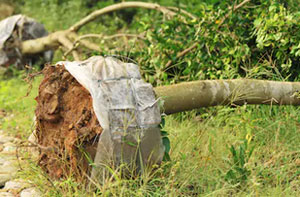
Re-planting fully developed trees is an intricate, yet rather simple process nowadays, mostly due to cutting-edge tractor mounted spades, tree lifting equipment and other specialised tools. Fully developed trees can be transplanted on new properties to achieve an instantly landscaped look, or out-of-control wooded areas could be thinned out without the need to resort to tree felling.
Transplanting a tree in Farington can be completed in any season of the year, however in warmer summer months, soaking the surrounding soil becomes especially vital so as to cause the minimum amount of stress on the tree's root-ball. Transplanting an adult tree involves a mechanical spade burrowing down and encompassing the tree's root ball, before raising the whole tree, unscathed, from the earth. If the tree is not to be straight away replanted, it can be temporarily stored as long as its root ball and the surrounding soil is kept moist.
Even protected trees can be moved and transplanted by a specialist tree moving contractor in Farington, so long as all applicable preservation orders and authorisations are approved by the woodland organisations and authorities. (Tags: Tree Transplanting Farington, Tree Replanting Farington, Tree Moving Farington).
Tree Stump Removal Farington
When a tree needs felling on your property in Farington, there's also a tree stump to consider. You might be thinking of using the stump as a quirky garden seat or some other useful feature, and might be perfectly happy to leave it in place until it rots away with time. However, a big tree stump could take a number of years to break down, and could even send out new suckers in an attempt to regrow itself. Protruding stumps can also be an eyesore, can attract unwelcome pests, and be a trip hazard for your family.
There are a number of ways that you can remove a tree stump, if you determine that this is the preferred plan of action, but the 2 key choices are stump grinding or stump removal. In the following few lines, we will be focusing on the different methods of removal.
Digging out by hand, burning or chemical treatment, are the three main methods of getting rid of a tree stump. If you want to have a crack at removing the tree stump for by yourself, you could try any one of these strategies where appropriate. If you are intending to bring in a tree surgeon to undertake the work, they are normally going to favour the aforementioned stump grinding approach, but a chemical removal treatment like eco-plugging might also be suggested.
Tree Stump Burning: Take care if you use this method of stump removal, as it can be quite dangerous and could be at variance with local legislation. Several one inch holes will have to be drilled in the tree stump, and for a few days continually topped up with vegetable oil. You can then cover the stump with charcoal or logs and set it alight. You or somebody will need to constantly monitor this until the fire has died down. Once it's finished burning, check that the fire is fully extinguished, leave it to cool down and then dig out the roots and burnt stump remains.
You will find there are various other stump burning solutions, such as digging a hole underneath the stump and setting a fire in the excavated space that's been made. If your tree stump is in close proximity to a building, fences or other trees, you shouldn't use any of these burning methods.
Chemical Stump Removers: For the chemical removal of a tree stump you will need to acquire Vitax SBK Stump Killer, Roundup Tree Stump Remover or Resolva Xtra Tough Tree Stump Killer. It's vital that you follow the directions closely when utilising any of these chemicals, because they can be toxic and dangerous. Your tree stump will take a few weeks to break down and can then be removed with an axe and spade.
Digging Out by Hand: The digging out of a tree stump by hand is a quite self-explanatory procedure, and will involve digging out all the earth at the base of the stump, exposing and sawing all the principal roots, and eventually freeing the stump so that it can be hoisted out. You may need to use a winch for lifting out the stump. This is really hard graft and is not for the faint-hearted or unfit.
(Tags: Stump Digging Farington, Removing Tree Stumps Farington, Removal of Tree Stumps Farington, Tree Stump Removal Farington).Tree Removal Farington
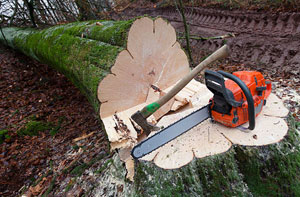
Though there are a variety of reasons why you may have to remove a tree from your garden or property in Farington, the removal of a tree should actually be a last resort. Certain trees may even be protected by law, so you couldn't get rid of them even though you would like to, except when they are a safety threat. Genuine triggers for removing a tree would be when the tree has grown too large, your tree is damaged, your tree is diseased/infected, your tree is hindering a new construction project, you've got a dead/dying tree, the roots of a tree are endangering retaining walls/foundations or the tree presents a safety risk.
Protecting Trees and Shrubs in Winter
Despite the fact that long periods of intense cold are quite rare in the British Isles it could still be worthwhile to think about some precautionary measures for protecting your shrubs and trees when the weather conditions turn bad. Even the plants, trees and shrubs that we usually think of as hardy, can find winter hard to endure, especially in the colder months, and they will always benefit from some TLC and extra protection.
When you've got trees on your property in Farington, it's high winds and storms that cause the biggest concerns, and they could still be vulnerable even though a lot of them will already have dropped their leaves come winter, offering less wind resistance. If the weather in Farington is windy, and a tree in your garden looks to be weakened or at risk of toppling over, it's recommended that you call in a tree surgeon to assess whether any action is required. Heavy snowfall can also lead to snapped branches, so keep your eyes open when this type of weather arrives. In the depths of winter, your trees and shrubs might need a little protection from ice and frost. Laying a thick covering of mulch round the stem bases will allow them to continue absorbing moisture and prevent the surrounding soil from freezing.
Crown Thinning Farington
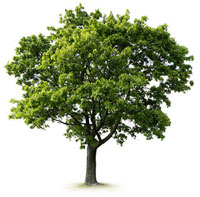
The elimination of a number of the lesser branches located on the tree's outer crown to produce a leaf density that's even throughout and does not change the shape or size of the tree, is generally referred to as crown thinning. Such a procedure is often only carried out on broad leafed trees (rather than conifers) and is to ease the stress on particular limbs as a result of wind, gravity, snow, or ice, to let more sunlight inside, to lower the overall weight of the crown, to reduce the chance of the tree being uprooted in windy conditions or to reduce the tree's wind resistance. A uniform foliage thickness around evenly spaced branches ought to be the arborist's objective when crown thinning, it should not transform the general structure and size of the tree.
Tree Cable Bracing Farington
When a tree presents a risk to nearby passers-by or property, or if it's showing signs of damage or decay, the tree can be offered extra support with a technique known as tree cable bracing. Where the wish is to avoid felling a tree or removing large, unstable sections, because the tree is valuable or old, cable bracing is the perfect solution.
A cable bracing system can be effective in supporting any poor joints, V-shaped forks and weak tree limbs that are causing concerns. Most Farington tree surgeons will be equipped to carry out different types of bracing work through the installation of cables and rods to alleviate structural stress and extend the lifespan of specimen trees.
The goal of cable bracing is to deliver a non-invasive means of support which does not damage the tree by drilling and bolting the branches, and is both shock-absorbing and flexible. Before any cable bracing work can start, an extensive risk risk assessment should be done to guarantee the safety of the tree and adjacent areas. (Tags: Cable Bracing Trees Farington, Cable Bracing Farington, Tree Cable Bracing Farington, Cable Bracing Techniques Farington).
Air-Spading Farington
When the health of your trees is a concern, this may be down to any one of a number of problems, but it is frequently because of issues with the root system. A professional Farington tree surgeon may need to gain access to the root system of your tree, so as to check for problems such as soil compaction or root rot.
This was sometimes a tricky thing to achieve during the past, because in the digging down process, the roots of the tree could be easily damaged. Many up-to-date and "savvy" tree surgeons in Farington use a system called "air spading", which uses compressed air to effectively break down and blow away compacted soil without any risk of damaging the tree's roots, or any utility lines that happen to be nearby.
The general health of a tree can be affected when the soil surrounding the roots becomes compacted by passing vehicles, building work or foot traffic. When a tree fails to get ample nutrients and water it can quickly become "stressed", and this means that it's more prone to attack by disease, pests and insects. Also great for correcting root flare issues, air-spading can be employed to successfully remove the excess soil from the base of a tree which has become covered, increasing the possibility of root decay.
By forcing air into voids in the soil at a speed of twelve hundred miles per hour by means of an air compressor and an air-spade, the air-spading process swiftly breaks down the soil without affecting the tree roots. Immediate inspection is possible, as the powerful flow of air blows the soil away from the roots. A resolution can then be found for any problems, and the previously compact soil replaced with wood chips and fertiliser to help rejuvenate the tree.
Dutch Elm Disease
A fungal disease which has wiped out tens of millons of precious elm trees right through Great Britain over the past five decades or more, Dutch Elm Disease (Ophiostoma novo-ulmi) is not quite as big an issue as it once was. Accidentally imported into Great Britain from Canada in the 1960s, DED (Dutch Elm Disease) is spread by the elm bark beetle (especially the Scolytus genus) and caused by a fungus called Ophiostoma novo-ulmi.
Through the nationwide movement of elm products like saplings, bark mulch, crates, and firewood logs with the bark on, it rapidly spread through Britain after first arriving. It wasn't just Great Britain that was affected by this dreadful disease, as the stocks of elms were also ravaged in mainland Europe, North America and New Zealand.
The signs of DED normally show up first in early summer, and can be recognised by:
- Dark spots or rings in the cross-section of twigs.
- Clusters of leaves that turn yellow, wilt and fall.
- Twigs turning into a "shepherd's crook".
- Shoots that die back from the tip.
The spread of this disease has been dramatically slowed down by the chopping down of dying, dead and infected trees, which has in essence eradicated the favourite habitat of the beetle. The propagation of young elm saplings that up to now have proven resistant to DED is being undertaken.
If you have elm trees in your garden in Farington, and are suspicious that they may be affected by Dutch Elm Disease, you should contact your neighbourhood tree surgeon for guidance, or request a diagnosis from the Tree Health Diagnostic & Advisory Service (THDAS).
Trees affected - Ulmus and Zelkova.
Agent of spread - beetles of the Scolytus genus.
Cause - fungi Ophiostoma Ulmi & Ophiostoma Novo-Ulmi.
(Tags: Dutch Elm Disease Farington, Spotting Dutch Elm Disease, Signs of Dutch Elm Disease).Accidents Through Tree Surgery
As we've already stated, tree care professionals in Farington carry out work that can be highly dangerous. With there being a considerable risk of injury to both operatives, co-workers and passers-by, all reasonable safety measures should be taken when carrying out work on trees.
It would appear (according to the HSE (Health & Safety Executive)), that the use of chainsaws, falls from trees, and being struck by a falling tree or branch are responsible for a large majority of fatal and major injuries that are related to tree work. Surprisingly, arborists and tree care specialists are more at risk of serious injury than workers involved in the construction industry.
The most commonplace tree work accidents in terms of insurance claims, involve falling from ladders, being struck by objects (grapple hooks, branches, ropes, cranes, trees etc) and lifting injuries.
This all demonstrates the need for employing a competent Farington tree surgeon to do any work on your trees. Most often, accidents in the tree care industry are a consequence of untrained novices taking on tree work that they aren't equipped for, nor skilled in. Using an established and trustworthy company which has been working in the Farington area for a number of years, is the easiest way to sidestep such issues, and get your tree care work done safely.
Invasive Tree Root Problems Farington

You may face problems when some trees that have exceptionally aggressive root systems are growing too close to your Farington house. Problems that may develop include damaged foundations, cracked patios and blocked drains. Sycamores, willows, elms and maples, are renowned for having extremely invasive root systems.
Complications can be avoided later on, if you make sure you plant new trees as far away as possible from your home, patios, your drainage system and paths. If pre-existing trees are growing too close to your dwelling and are causing some of these problems, you must call in a tree surgeon in Farington, to see what can be done.
If you wish to avoid killing off the tree or severely affecting it's health you really shouldn't attempt to do this yourself and just chop off any offending roots. So that the damage is reduced, and the tree can still get enough food and water to survive and thrive, a qualified tree surgeon in Farington will know which roots should be left in place, and which roots can be safely cut back.
Tree and shrub roots frequently cause structural problems in underground drainage systems, since sewage lines provide a continuous source of nutrients and water. A drainage system's joints can soon be compromised by tiny roots, which when established can grow into huge root balls and eventually cause blockages and joint failure. High quality root removal solutions will be offered by some local tree surgeons, who will use either high pressure jetting, electro-mechanical equipment or manual rodding to eliminate the offending roots. (Tags: Drain Root Removal Farington, Tree Root Problems Farington, Invasive Tree Roots Farington, Problematic Tree Roots Farington).
Logs & Firewood Farington
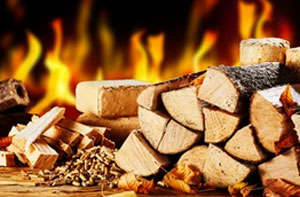
If you happen to be in the market for firewood or logs in Farington, tree surgeons are often a great source for this useful commodity. As tree surgeons spend the majority of their days cutting down branches and trees, I suppose this is no great surprise.
Some tree surgeons in and around Farington may be willing to let you have branches and logs free of charge, as they've always got plenty of them to dispose of, while others will charge you for seasoned and chopped logs which are dried out and ready to burn.
Logs with a moisture content of under twenty percent are ideal for burning on your log burning stove or open fire, and these should have been dried out for twelve months or more. Typically tree surgeons in Farington will have stocks of hardwood logs, and the benefit of these is that they give a long, sustained burn, providing 3 or 4 hours of heat. The disadvantage of hardwood is that it can be quite difficult to get going, therefore if you are able to pick up a few softwood logs, these are wonderful for initially getting a fire started.
Chainsaws in Tree Surgery

The most dangerous and arguably the most widely used tool employed by tree surgeons in Farington, is the chainsaw. Despite the fact that battery and mains versions of chainsaw are available, the most preferred by tree care professionals are driven by petrol, due to their ease of use and portability. Where thick branches and large trunks are involved, such substantial tree work necessitates the use of the most robust petrol driven chainsaws.
A chainsaw is essentially composed of a revolving engine-driven chain which is lined with a set of teeth that cut through the bark and inner wood of a tree. There are also a variety of styles of chainsaw, top-handled for working at height (and which can be used with one hand if required), pole saws for hard to reach branches and long distance pruning and rear-handled for working on the ground (must always be used with two hands).
You'll very rarely find a tree surgeon in Farington who does not use a chainsaw, despite the fact that working at height a tree with a twirling blade in your hand isn't is not the safest way to spend your day. All professional tree surgeons must be trained in the safe use of chainsaws, and it is one of the key conditions for becoming a registered member of the AA (Arboricultural Association).
For any individual interested in purchasing a chainsaw in the UK, there are various makes on the market, however the most preferred by Farington professionals are Hyundai, Makita, Stihl and Husqvarna.
Coming Soon: Tree pruning Farington.
Tree Surgery Tasks Farington

Farington tree surgeons can usually help with forestry management Farington, tree watering, crown raising, damage restoration, air spading, landscape clearing Farington, tree topping, tree cutting, terravention, conrolling pests in Farington, cable bracing, woodland clearances, tree dismantling, tree management, tree maintenance, hedge trimming, woodland management, brush cutting, crown thinning, staking, tree waste removal, root flare exposure, tree lightening protection, crown removal, stump treatment, hedge planting, tree pruning, site clearance Farington, root decompaction Farington, hedge lowering, tree transplanting, root grinding, tree planting, fruit tree pruning, vegetation management Farington and other tree surgeon services in Farington, Lancashire. These are just a handful of the activities that are undertaken by a local tree surgeon. Farington specialists will be happy to tell you about their whole range of services.
Obtaining Assistance and Help
To guarantee that you employ a tree surgeon or arborist who's both competent and who will not inflict permanent damage on your trees, there are a number of questions you must ask when searching for a tree surgeon in Farington. Suitable questions should be something like: Do your working practices adhere to the British Standard? Are you able to provide me with references from former customers? Can you give me a written quotation? Have you got public liability and employers insurance? Are you joined to a reputable professional trade organisation (such as The International Society of Arboriculture or the Arboricultural Association)? Do your workers and you have the appropriate qualifications and certifications (for tree management and the use of chainsaws)? You should continue looking for a tree surgeon if you do not get acceptable responses to any or all of these basic questions.

To find an abundance of practical info regarding how to pick a good tree surgeon, in addition to a comprehensive directory of certified tree surgeons in the United Kingdom, you can visit the Arboricultural Association (AA) website. The ISA is another fantastic resource which includes a "verify tree surgeon's credentials" tool and a "find an arborist" tool. You could also go to the trusty Wikipedia "Arborist" webpage here, to study lots more details on tree surgery as a career. Trustmark is a Government approved website which is also a splendid stop-off-point for finding authentic trades-people.
Tree Surgeons Near Farington: Also find: Howick Cross tree surgeons, Buckshaw Village tree surgeons, Penwortham Lane tree surgeons, Whittle-le-Woods tree surgeons, New Longton tree surgeons, Leyland tree surgeons, Farington Moss tree surgeons, Clayton-le-Woods tree surgeons, Bamber Bridge tree surgeons, Tardy Gate tree surgeons, Midge Hall tree surgeons, Whitestake here. All these locations are served by a local tree surgeon. Farington business and home owners can get tree surgery estimates by going here.
Tree Care Services Farington
- Farington Site Clearance
- Farington Eco-Plugging
- Farington Crown Reduction
- Farington Tree Maintenance
- Farington Tree Pruning
- Farington Tree Pollarding
- Farington Tree Surveys
- Farington Soil Terravention
- Farington Tree Removal
- Farington Woodland Management
- Farington Crown Thinning
- Farington Shrub Maintenance
- Farington Root Removal
- Farington Tree Topping
Tree Surgeons Around Farington: Just recently, homeowners in the following Farington locations have sent in enquiries about tree surgery: Greenfield Drive, Lever House Lane, Mill Lane, Gainsborough Avenue, Buffalo Road, Morland Avenue, Malton Drive, Stoney Lane, Boegrave Avenue, Badger Road, Stanifield Close, Lodge View, Wellfield Road, County Close, Lower Field, William Street, Five Acres, Barnfield, Centurion Way, Kentmere Avenue, Nook Lane, Riverside Close, St Clements Avenue, Stanley Avenue, Old Street, Great Meadow, and in these nearby postcodes PR25 4QU, PR25 3RD, PR25 3XG, PR25 3RA, PR25 3DD, PR25 4YR, PR25 3UQ, PR25 4QA, PR25 4QT, PR25 4AB. These places recently saw activity by a local tree surgeon. Farington home and property owners enjoyed trusted and reliable tree surgery services in all cases.
 Tree Surgeon Farington
Tree Surgeon Farington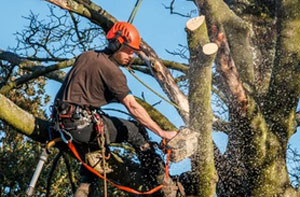 Tree Surgeons Farington
Tree Surgeons Farington Tree Surgery Farington
Tree Surgery FaringtonMore Lancashire Tree Surgeons: Lancashire tree surgeons: Burscough, Great Harwood, Clayton-le-Moors, Blackburn, Ormskirk, Leyland, Carnforth, Rishton, Coppull, Euxton, Morecambe, Tarleton, Clayton-le-Woods, Freckleton, Fulwood, Fleetwood, Farington, Oswaldtwistle, Preesall, Skelmersdale, Darwen, Appley Bridge, Helmshore, Barrowford, Bacup, Preston, Aughton, Burnley, Accrington, Lancaster, Whitworth, Padiham, Heysham, Clitheroe, Up Holland, Brierfield, Barnoldswick, Blackpool, Livesey, Bispham, Haslingden, Garstang, Bamber Bridge, Chorley, Thornton Cleveleys, Adlington, Poulton-le-Fylde, Penwortham, Poulton, Lytham St Annes, Earby, Colne, Longridge, Rawtenstall, Nelson and Kirkham.
Tree Surgeon Jobs Farington: Find Farington tree surgeon jobs here: Farington Tree Surgeon Jobs
If you want local information relating to Farington, Lancashire take a look here
Tree Surgery PR25 area, telephone code 01772.
More Trades: Gate Fitters - Gutter Cleaning - Tilers - Carpet Fitters - Carpenters
Tree Surgeons Farington - Vegetation Management Farington - Tree Care Farington - Forest Management Farington - Tree Surgery Farington - Arboriculturalist Farington - Tree Surgeon Near Me - Stump Grinding Farington - Tree Surgeon Farington





